Mutant Storm Empire
High-pressure front.
Lots of games do the trick of asking you to dodge things with one thumb while you shoot back with the other. Robotron and Geometry Wars, for example, or the first two Mutant Storm games for another. These are by no means isolated examples. And I'm not just talking about the way I grouped them in little pairs, either - two-stick shooters are so common these days that you could slap a few public footpaths on top and call them green-space.
Good ones, like Mutant Storm Empire, are tricky, but fair. They introduce enemies and obstacles openly, making sure you've spotted them, and establish attack and defence patterns that are easy to identify but difficult to routinely overcome without skill and practice. And though they are repetitive, they use that repetition to their advantage - Geometry Wars bubbles up and up until it's hard not to burn yourself repeatedly to death, but it changes the ingredients on each go, so you end up having to apply what you know about each type of enemy to all sorts of different swarms.
Mutant Storm Empire starts off building similar themes. The first enemies will appear virtually benign to most shmup fans, marching single-file onto the screen and dying quickly, but the object is more to impart the combo system, which works by counting the amount of enemies of one type you've killed in a row and then rewarding you if you can chain alternating sequences of particular lengths. Gradually, as you move through the first world's different chambers, you're exposed to more aggressive enemies - some fire projectiles, some spit out smaller objects that flood the screen, some go after you directly. All adhere to their own set of rules and behaviours.

And then the game stops warming up and becomes interesting. Rather than sticking rigidly to the idea of having to finish five rooms in a row per level, and going back to the start of whichever level you're on when you lose your six starting lives, it does single-chamber levels of longer length, and it does levels where you're as a passenger, trapped between a pair of vertical laser beams which sweep along a pathway of stationary turrets, floods of explosive blocks and colourful spaceships. Pillars, and changes in arena shape - sometimes mid-level - force you to adjust strategies that worked perfectly well out in the open, and the audacity of certain variations raises a smile to hardened lips.
It's not going to make you fall off your seat or anything, but it gets the difficult fundamentals right, and then hangs enjoyable scenarios sensibly along a consistent difficulty curve that spans 16 levels, throwing in a few crutches (five difficulty settings per level, with an escalating points return when you move up a rank; a time-limited blue "special laser", which kills things quicker; six fresh new lives for each fresh new level; level-by-level unlocks rather than world-by-four-level-world), and generally compelling you to its end, which is a particularly decent four levels of shmup fun. The final boss, in particular, is a blend of familiar elements in an engaging way.
Once you're done, you've got the option of touring the game with a friend locally or over the Internet, and this does a much better job than some other two-stick co-op shooters we could mention (stand up Assault Heroes - so I can hit you again), as you dispatch each other to take care of particular threats, developing routines and strategies quite apart from your typical single-player endeavours, and in the face of different odds.

Of most interest to shmup devotees though is the clever pairing of Adventure and Tally single-player modes. The former is your standard, get-to-the-end single-player mode, which builds up a score from zero up to the point you run out of six lives and die. If you can sustain yourself over several levels without once losing all six, you get a cumulative score for those when you finally snuff it. Tally, though, allows you to replay unlocked levels and then banks your best score for each, adding them all together to give you an overall game score. PomPom tells me that people use Tally mode to practise and then string big Adventure mode play-throughs together for ultimate bragging rights. Sadly I'm nowhere near good enough to do this, but if it's your kind of thing then it's worth knowing about.
There's a definite question mark over the game's longevity for anyone who isn't into that, or doesn't have a friend to play it with afterward, but providing you know what you'll need to be into to continue enjoying it once it's over, it seems worthy of fair praise. The only things that stop it reaching higher are that the combo system seems to be pitched a little bit above the average gamer's skill level, and could have been more inclusive, and that despite getting the basics very right it doesn't build on that as excitingly or inventively as some of the genre's best. Even so, if you're looking for a new shoot-'em-up on Xbox Live Arcade, this is it.

